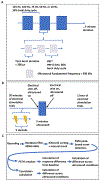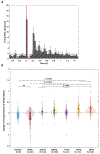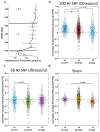Transcranial ultrasound neuromodulation induces neuronal correlation change in the rat somatosensory cortex
- PMID: 35947970
- PMCID: PMC9514023
- DOI: 10.1088/1741-2552/ac889f
Transcranial ultrasound neuromodulation induces neuronal correlation change in the rat somatosensory cortex
Abstract
Objective.Transcranial focused ultrasound (tFUS) is a neuromodulation technique which has been the focus of increasing interest for noninvasive brain stimulation with high spatial specificity. Its ability to excite and inhibit neural circuits as well as to modulate perception and behavior has been demonstrated, however, we currently lack understanding of how tFUS modulates the ways neurons interact with each other. This understanding would help elucidate tFUS's mechanism of systemic neuromodulation and allow future development of therapies for treating neurological disorders.Approach.In this study, we investigate how tFUS modulates neural interaction and response to peripheral electrical limb stimulation through intracranial multi-electrode recordings in the rat somatosensory cortex. We deliver ultrasound in a pulsed pattern to induce frequency dependent plasticity in a manner similar to what is found following electrical stimulation.Main Results.We show that neural firing in response to peripheral electrical stimulation is increased after ultrasound stimulation at all frequencies, showing tFUS induced changes in excitability of individual neuronsin vivo. We demonstrate tFUS sonication repetition frequency dependent pairwise correlation changes between neurons, with both increases and decreases observed at different frequencies.Significance.These results extend previous research showing tFUS to be capable of inducing synaptic depression and demonstrate its ability to modulate network dynamics as a whole.
Keywords: frequency dependent plasticity; neuromodulation; tFUS; transcranial focused ultrasound.
© 2022 IOP Publishing Ltd.
Figures








Similar articles
-
Transcranial focused ultrasound induces sustained synaptic plasticity in rat hippocampus.Brain Stimul. 2022 Mar-Apr;15(2):352-359. doi: 10.1016/j.brs.2022.01.015. Epub 2022 Jan 30. Brain Stimul. 2022. PMID: 35104664 Free PMC article.
-
Transcranial focused ultrasound remotely modulates extrastriate visual cortex by stimulating frontal eye field with subregion specificity.J Neural Eng. 2024 Nov 28;21(6):066018. doi: 10.1088/1741-2552/ad9406. J Neural Eng. 2024. PMID: 39556944 Free PMC article.
-
Neuromodulatory Responses Elicited by Intermittent versus Continuous Transcranial Focused Ultrasound Stimulation of the Motor Cortex in Rats.Int J Mol Sci. 2024 May 23;25(11):5687. doi: 10.3390/ijms25115687. Int J Mol Sci. 2024. PMID: 38891875 Free PMC article.
-
Advances in transcranial focused ultrasound neuromodulation for mental disorders.Prog Neuropsychopharmacol Biol Psychiatry. 2025 Jan 10;136:111244. doi: 10.1016/j.pnpbp.2024.111244. Epub 2025 Jan 3. Prog Neuropsychopharmacol Biol Psychiatry. 2025. PMID: 39756638 Review.
-
The promise of transcranial focused ultrasound in disorders of consciousness: a narrative review.Crit Care. 2025 Mar 12;29(1):109. doi: 10.1186/s13054-025-05338-2. Crit Care. 2025. PMID: 40075493 Free PMC article. Review.
Cited by
-
Parameter-dependent cell-type specific effects of transcranial focused ultrasound stimulation in an awake head-fixed rodent model.J Neural Eng. 2025 Mar 19;22(2):026022. doi: 10.1088/1741-2552/adbb1f. J Neural Eng. 2025. PMID: 40014879 Free PMC article.
-
Mechanical artifacts during transcranial focused ultrasound mimic biologically evoked responses.Brain Stimul. 2025 Jul-Aug;18(4):1094-1096. doi: 10.1016/j.brs.2025.05.114. Epub 2025 May 15. Brain Stimul. 2025. PMID: 40381936 Free PMC article. No abstract available.
-
Improving Targeting Specificity of Transcranial Focused Ultrasound in Subject Specific Head Models Using a Random Array Transducer: A k-Wave Simulation Study.IEEE Access. 2025;13:113179-113193. doi: 10.1109/access.2025.3584245. Epub 2025 Jun 30. IEEE Access. 2025. PMID: 40843191 Free PMC article.
-
Transcranial Magneto-Acoustic Stimulation Protects Synaptic Rehabilitation from Amyloid-Beta Plaques via Regulation of Microglial Functions.Int J Mol Sci. 2024 Apr 24;25(9):4651. doi: 10.3390/ijms25094651. Int J Mol Sci. 2024. PMID: 38731870 Free PMC article.
-
Evaluation of the effects of focused ultrasound stimulation on the central nervous system through a multiscale simulation approach.Front Bioeng Biotechnol. 2022 Dec 1;10:1034194. doi: 10.3389/fbioe.2022.1034194. eCollection 2022. Front Bioeng Biotechnol. 2022. PMID: 36532581 Free PMC article.
References
Publication types
MeSH terms
Grants and funding
LinkOut - more resources
Full Text Sources
